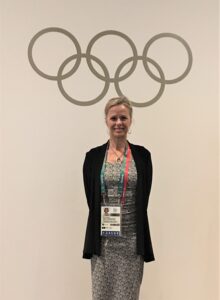In “past, present, future” we ask clinical or academic experts to reflect on selected Sports & Exercise Medicine topics. Today Margo Mountjoy on Relative Energy Deficiency in Sport (RED-S).

Tell us more about yourself
I am a clinician scientist (MD PhD) from Canada. Clinically, I am a team physician with Athletics Canada, and work for the International Sport Federations of FINA, FIFA and World Rugby. I am a member of the IOC Medical Commission Games Group, WADA Health, Medicine and Research Committee, and Chair of the ASOIF medical + scientific consultative group. I have the privilege of chairing the author team of the IOC consensus statement on Relative Energy Deficiency in Sport. (RED-S). I am active in the field of RED-S from both the aspects of scientific research and clinical care application.
What was hip and happening 10 years ago?
Ten years ago, the term RED-S did not even exist. The scientific focus in the early 2010 decade was on the female athlete triad, and the scientific publications reflected advances in the links between low energy availability and menstruation and/or bone health in female athletes. This pivotal science laid the foundation for the broadening of the Triad concept to RED-S in 2014/2015.
Hip and happening otherwise? Ten years ago, was the time period in between the Vancouver (2010) and London (2012) Olympic Games. I recall at this time focusing my attention on expanding the IOC vision from physical injury prevention to one inclusive of illness prevention. This groundwork also was foundational in ensuring the support for the introduction of RED-S in the field of sport medicine: athlete health and well-being is not only about musculo-skeletal injuries!
What are we doing now?
The field of RED-S has exploded, and I am delighted with the attention of researchers, clinicians and coaches to the health and performance effects of low energy availability. There are many research centres around the world who are producing ‘game changing’ research of RED-S in female and male athletes, and in ‘non-traditional’ sports. There is also much work being done at the molecular level to better understand the underpinning physiological pathways linking low energy availability with the clinical syndrome of RED-S. It is an exciting time to be a clinician and/or scientist in this field of athlete health and well-being.
Where do you think we will be 10 years from now?
I believe that in 10 years-time we will have much more scientific progress of knowledge in the area of RED-S in male athletes and in athletes from ethnically diverse geographic areas and cultures. My hope is that knowledge translation initiatives will also be significantly advanced, with evaluation of clinical interventions, and measurement of changes in coach and athlete knowledge, behaviours, and attitudes around RED-S. Most importantly, I look forward to seeing the spot light focused on the athlete voice who experience RED-S.